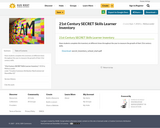
Have students complete this inventory at different times throughout the year to measure the growth of their 21st century skills.
- Subject:
- Education
- Material Type:
- Activity/Lab
- Assessment
- Homework/Assignment
- Date Added:
- 09/07/2018

Have students complete this inventory at different times throughout the year to measure the growth of their 21st century skills.
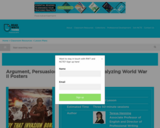
Students analyze World War II posters, as a group and then independently, to explore how argument, persuasion and propaganda differ.
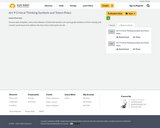
A lesson plan template, rubric and collection of links that teachers can use to guide students to think critically and connect social issues that address the story that a totem pole can tell.

Lesson Ideas: A good preface, what is rhetoric? Three kinds of proof, 5 canons of Rhetoric, Euphemisms, Dysphemisms, Slanters, Fallacies, Deductive versus Inductive Reasoning, Logic, Arugment Map, Communication Model, Fact Check

In this lesson, students consider the different factors that make online sources reliable or unreliable. They then learn quick steps they can take to gauge an online source’s reliability and practice these steps by playing an interactive online game. Finally, students create a media product to teach other students how to do one of the tactics they’ve learned.
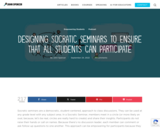
Socratic seminars are a democratic, student-centered, approach to class discussions. They can be used at any grade level with any subject area. In a Socratic Seminar, members meet in a circle and share their insights. Participants do not raise their hands or call on names. Because there’s no discussion leader, each member can comment or ask follow-up questions to one another. This approach can be empowering for participants because they own the conversation. Unlike a typical class discussion, the conversation moves fluidly back and forth rather than having to go through the teacher.
This article outlines several approaches to conducting a Socratic Seminar:
- The Giant Circle Approach
- The “Fish Bowl” Approach
- The Round Table Approach
- The Scattered Approach
- Multiple Seminars
- Online/Offline Seminars
The author also provides a sample of how to run a Socratic Seminar and tips for ensuring that all students can participate.
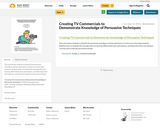
This unit teaches students to identify the persuasive techniques used by
advertisers to entice you to buy their products. Students learn to evaluate the
messages they are hearing, differentiate facts and opinions, and determine their
own opinions. I use this unit to lead into persuasive writing.
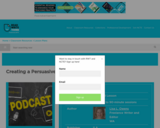
Students learn how to get their voice out on the web when they research issues important to them and compose a persuasive podcast to post online.

Critical Thinking Cheat Sheet from Wabisabi Learning.
This great resource looks at the who, what, where, when, why and how of critical thinking.
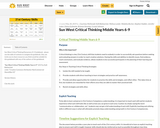
Sun West Critical Thinking Middle Years 6-9 Guidebook - please use the table of contents to navigate the guidebook. Also, we invite you to share resources you think would be suitable for this guidebook with any of the authors of this guidebook.
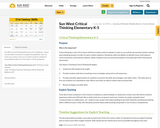
Sun West Critical Thinking Elementary K-5 Guidebook - please use the table of contents to navigate the guidebook. Also, we invite you to share resources you think would be suitable for this guidebook with any of the authors of this guidebook.

Set of posters and conversation starts for students to focus on Critical Thinking and Justifying their answers. Students provide the opportunity to evaluate.
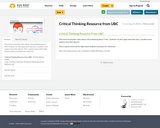
This resource provides video about critical thinking (about 7 min). Students can then apply what they learn, visualize it and explore more links about it.
This is a great resourced for high school students to prepare for university!

About This Workbook
The activity pages in the Critical Thinking
Workbook are meant to be shared and explored.
Use it as an electronic document or as worksheets.
You can either print off the pages and use them as
activity sheets, or you can edit them directly right in
the document on your computer.
Enjoy these fun and challenging critical
thinking activities that will get every
student thinking critically!
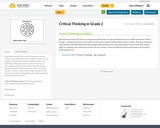
My goal was to bring 21st Century Competences with the focus of critical thinking into my Gr. 2 Math classroom. I show a droodle – an abstract drawing. I ask students to take a few moments and think about what it could be. Then they can discuss with a partner, and finally share what they thought. Afterwards we have a discussion around “right” and “wrong” answers – which is a common way to think around math. No one is wrong – these are all good ideas that could answer the question: What could this be?
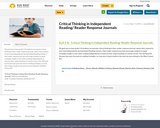
My goal was to have grade 5-8 students incorporate critical thinking in their reader response journals, where they respond to text read independently during Guided Reading stations. I feel reader response journals encourage students to apply strategies taught in class when reading independently to improve their understanding of a variety of text. Our SLIP goal for the past two years focused on reading strategies, so I was also trying to build on the work we were doing for the West Colony PLT.

Students write persuasive letters to their librarian requesting that specific texts be added to the school library. As they work, students plan their arguments and outline their reasons and examples.

Students practice the initial steps involved in an engineering design challenge. They begin by reviewing the steps of the engineering design loop and discussing the client need for the project. Next, they identify a relevant context, define the problem within their design teams, and examine the project's requirements and constraints. (Note: Conduct this activity in the context of a design project that students are working on, which could be a challenge determined by the teacher, brainstormed with the class, or the example project challenge provided [to design a prosthetic arm that can perform a mechanical function].)

This activity was designed for blind learners, but all types of learners can use it to understand the design process and produce a design for a product meant to solve a specific problem.
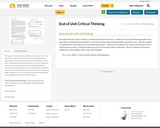
Throughout the year I have used this as a review for the end of each unit. I create five or six critical thinking questions that apply what we have been learning about. I print them on color paper and spread them around the room. I pair the students up, and have they move about the room solving the questions. I only have ten students in my class so I’m fortunate to have only five pairs at a time. I usually pair them up as sort of a strong and weak combination. This is an attempt to have them collaborate on the problems while using critical thinking.